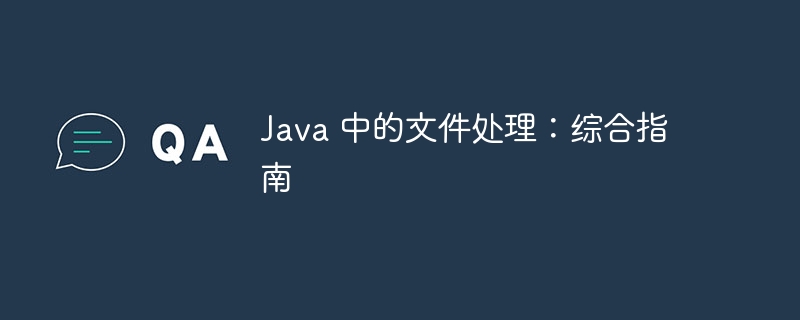Java 中的文件处理:综合指南(文件.指南.综合.Java...)

文件处理是任何编程语言的重要组成部分。在 java 中,java.io 和 java.nio 包提供了用于读取和写入文件(文本和二进制)的强大类。本指南涵盖了 java 文件处理的基础知识,包括示例、挑战和技巧,可帮助您掌握该主题。
1.读取和写入文本文件 读取文本文件java提供了多种读取文本文件的方法,但最常见、最简单的方法是使用bufferedreader和filereader。
示例:
import java.io.bufferedreader;
import java.io.filereader;
import java.io.ioexception;
public class textfilereader {
public static void main(string[] args) {
try (bufferedreader reader = new bufferedreader(new filereader("example.txt"))) {
string line;
while ((line = reader.readline()) != null) {
system.out.println(line);
}
} catch (ioexception e) {
e.printstacktrace();
}
}
}
要点:
- bufferedreader 高效地逐行读取文本。
- try-with-resources 语句确保资源自动关闭。
使用 bufferedwriter 和 filewriter 写入文本文件同样简单。
示例:
import java.io.bufferedwriter;
import java.io.filewriter;
import java.io.ioexception;
public class textfilewriter {
public static void main(string[] args) {
try (bufferedwriter writer = new bufferedwriter(new filewriter("example.txt"))) {
writer.write("hello, world!");
writer.newline();
writer.write("this is a text file.");
} catch (ioexception e) {
e.printstacktrace();
}
}
}
挑战:编写一个 java 程序,逐行读取文本文件并计算文件中的单词数。
2.读写二进制文件二进制文件需要不同的方法,因为它们不是人类可读的。 java 的 fileinputstream 和 fileoutputstream 类非常适合读取和写入二进制数据。
读取二进制文件示例:
import java.io.fileinputstream;
import java.io.ioexception;
public class binaryfilereader {
public static void main(string[] args) {
try (fileinputstream inputstream = new fileinputstream("example.dat")) {
int bytedata;
while ((bytedata = inputstream.read()) != -1) {
system.out.print(bytedata + " ");
}
} catch (ioexception e) {
e.printstacktrace();
}
}
}
要点:
- fileinputstream 逐字节读取数据。
- 对于图像或序列化对象等文件很有用。
示例:
import java.io.fileoutputstream;
import java.io.ioexception;
public class binaryfilewriter {
public static void main(string[] args) {
try (fileoutputstream outputstream = new fileoutputstream("example.dat")) {
outputstream.write(65); // writes a single byte to the file
outputstream.write(new byte[]{66, 67, 68}); // writes multiple bytes to the file
} catch (ioexception e) {
e.printstacktrace();
}
}
}
挑战:编写一个程序,将二进制文件(如图像)从一个位置复制到另一个位置。
3.从 zip 文件读取java 的 java.util.zip 包允许您使用 zip 文件。您可以使用 zipinputstream 从 zip 存档中提取文件。
示例:import java.io.fileinputstream;
import java.io.fileoutputstream;
import java.io.ioexception;
import java.util.zip.zipentry;
import java.util.zip.zipinputstream;
public class zipfilereader {
public static void main(string[] args) {
try (zipinputstream zipstream = new zipinputstream(new fileinputstream("example.zip"))) {
zipentry entry;
while ((entry = zipstream.getnextentry()) != null) {
system.out.println("extracting: " + entry.getname());
fileoutputstream outputstream = new fileoutputstream(entry.getname());
byte[] buffer = new byte[1024];
int len;
while ((len = zipstream.read(buffer)) > 0) {
outputstream.write(buffer, 0, len);
}
outputstream.close();
zipstream.closeentry();
}
} catch (ioexception e) {
e.printstacktrace();
}
}
}
要点:
- zipinputstream 从 zip 文件中读取条目。
- 每个条目(文件或目录)都可以使用循环提取。
挑战:编写一个 java 程序,从 zip 存档中读取所有 .txt 文件并将其内容打印到控制台。
4.写入 office 文件java 本身不支持写入 microsoft office 文件(例如 .docx 或 .xlsx),但可以使用 apache poi 等库来实现此目的。
写入 excel 文件示例:
import org.apache.poi.ss.usermodel.*;
import org.apache.poi.xssf.usermodel.xssfworkbook;
import java.io.fileoutputstream;
import java.io.ioexception;
public class excelfilewriter {
public static void main(string[] args) {
workbook workbook = new xssfworkbook();
sheet sheet = workbook.createsheet("sheet1");
row row = sheet.createrow(0);
cell cell = row.createcell(0);
cell.setcellvalue("hello, excel!");
try (fileoutputstream outputstream = new fileoutputstream("example.xlsx")) {
workbook.write(outputstream);
} catch (ioexception e) {
e.printstacktrace();
}
}
}
挑战:编写一个 java 程序,创建一个包含多个工作表的 excel 文件,每个工作表包含一个数据表。
5.读取和写入 xml 文件java 提供了多种处理 xml 文件的方法。 javax.xml.parsers 包通常用于此目的。
读取 xml 文件示例:
import javax.xml.parsers.documentbuilder;
import javax.xml.parsers.documentbuilderfactory;
import org.w3c.dom.document;
import org.w3c.dom.nodelist;
import java.io.file;
public class xmlfilereader {
public static void main(string[] args) {
try {
file file = new file("example.xml");
documentbuilderfactory factory = documentbuilderfactory.newinstance();
documentbuilder builder = factory.newdocumentbuilder();
document doc = builder.parse(file);
nodelist nodelist = doc.getelementsbytagname("tagname");
for (int i = 0; i
<h4>
<strong>写入 xml 文件</strong>
</h4>
<p><strong>示例:</strong><br></p>
<pre class="brush:php;toolbar:false">import javax.xml.parsers.documentbuilderfactory;
import javax.xml.parsers.parserconfigurationexception;
import javax.xml.transform.*;
import javax.xml.transform.dom.domsource;
import javax.xml.transform.stream.streamresult;
import org.w3c.dom.document;
import org.w3c.dom.element;
import java.io.file;
public class xmlfilewriter {
public static void main(string[] args) {
try {
documentbuilderfactory factory = documentbuilderfactory.newinstance();
documentbuilder builder = factory.newdocumentbuilder();
document doc = builder.newdocument();
element root = doc.createelement("root");
doc.appendchild(root);
element child = doc.createelement("child");
child.appendchild(doc.createtextnode("hello, xml!"));
root.appendchild(child);
transformerfactory transformerfactory = transformerfactory.newinstance();
transformer transformer = transformerfactory.newtransformer();
transformer.setoutputproperty(outputkeys.indent, "yes");
domsource source = new domsource(doc);
streamresult result = new streamresult(new file("example.xml"));
transformer.transform(source, result);
} catch (parserconfigurationexception | transformerexception e) {
e.printstacktrace();
}
}
}
挑战:创建一个 java 程序,读取 xml 配置文件并以人类可读的格式输出设置。
6.文件 i/o 中的异常处理处理文件时,由于文件丢失、权限错误或意外的数据格式等问题,异常很常见。正确的异常处理对于健壮的程序至关重要。
常见 i/o 异常- filenotfoundexception: 尝试打开不存在的文件时发生。
- ioexception: i/o 失败的一般异常,例如读取或写入错误。
最佳实践:
- 使用 try-with-resources:这可以确保即使发生异常,文件也能正确关闭。
- 特定的捕获块:分别处理不同的异常以提供有意义的错误消息。
- 日志记录:始终记录异常以帮助诊断生产中的问题。
示例:
import java.io.BufferedReader;
import java.io.FileReader;
import java.io.IOException;
public class FileExceptionHandling {
public static void main(String[] args) {
try (BufferedReader reader = new BufferedReader(new FileReader("example.txt"))) {
String line;
while ((line = reader.readLine()) != null) {
System.out.println(line);
}
} catch (IOException e) {
System.err.println("An I/O error occurred: " + e.getMessage());
}
}
}
结论
java 中的文件处理是一项强大的功能,使您能够处理各种文件类型,从简单的文本文件到复杂的 xml 和二进制文件。通过掌握这些技术,您将能够很好地处理 java 应用程序中任何基于文件的任务。
最终挑战:结合读写技术创建一个程序,从 excel 文件读取数据,处理数据,然后将结果写入新的 xml 文件。
提示与技巧:
- 缓冲: 对于大文件始终使用缓冲(bufferedreader、bufferedwriter)以提高性能。
- 文件路径: 使用 java.nio.file 中的路径和文件类进行更现代、更灵活的文件处理。
- utf-8 编码: 处理文本文件时始终指定字符编码,以避免编码问题。
编码愉快!
以上就是Java 中的文件处理:综合指南的详细内容,更多请关注知识资源分享宝库其它相关文章!
